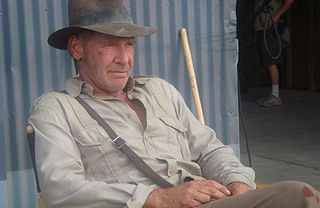
Dr. Henry Walton "Indiana" Jones, Jr. is the title character and protagonist of the Indiana Jones franchise. George Lucas created the character in homage to the action heroes of 1930s film serials. The character first appeared in the 1981 film Raiders of the Lost Ark, to be followed by Indiana Jones and the Temple of Doom in 1984, Indiana Jones and the Last Crusade in 1989, The Young Indiana Jones Chronicles from 1992 to 1996, Indiana Jones and the Kingdom of the Crystal Skull in 2008, and Indiana Jones and the Dial of Destiny in 2023. The character is also featured in novels, comics, video games, and other media. Jones is also the inspiration for several Disney theme park attractions, including Indiana Jones and the Temple of Peril, the Indiana Jones Adventure, and Epic Stunt Spectacular! attractions.

Lucasfilm Games is an American video game licensor and a subsidiary of Lucasfilm. It was founded in May 1982 by George Lucas as a video game development group alongside his film company; as part of a larger 1990 reorganization of the Lucasfilm divisions, the video game development division was grouped and rebranded as part of LucasArts. LucasArts became known for its line of adventure games based on its SCUMM engine in the 1990s, including Maniac Mansion, the Monkey Island series, and several Indiana Jones titles. A number of influential game developers were alumni of LucasArts from this period, including Brian Moriarty, Tim Schafer, Ron Gilbert, and Dave Grossman. Later, as Lucasfilm regained control over its licensing over the Star Wars franchise, LucasArts produced numerous action-based Star Wars titles in the late 1990s and early 2000s, while dropping adventure game development due to waning interest in the genre.
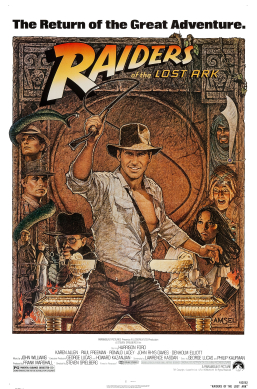
Raiders of the Lost Ark is a 1981 American action-adventure film directed by Steven Spielberg from a screenplay by Lawrence Kasdan, based on a story by George Lucas and Philip Kaufman. Set in 1936, the film stars Harrison Ford as Indiana Jones, a globetrotting archaeologist vying with Nazi German forces to recover the long-lost Ark of the Covenant which is said to make an army invincible. Teaming up with his tough former romantic interest Marion Ravenwood, Jones races to stop rival archaeologist René Belloq from guiding the Nazis to the Ark and its power.

Indiana Jones and the Last Crusade: The Graphic Adventure is a graphic adventure game, released in 1989 by Lucasfilm Games, coinciding with the release of the film of the same name. It was the third game to use the SCUMM engine.
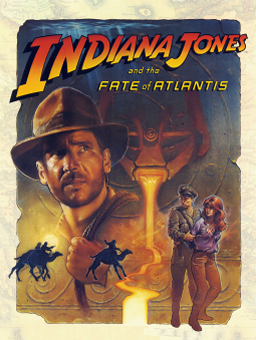
Indiana Jones and the Fate of Atlantis is a point-and-click adventure game developed and published by LucasArts and released in June 1992 for Amiga, DOS, and Macintosh. Almost a year later, it was reissued on CD-ROM as an enhanced "talkie" edition with full voice acting and digitized sound effects. The seventh game to use the script language SCUMM, Fate of Atlantis has the player explore environments and interact with objects and characters by using commands constructed with predetermined verbs. It features three unique paths to select, influencing story development, gameplay and puzzles. The game used an updated SCUMM engine and required a 286-based PC, although it still runs as a real-mode DOS application. The CD talkie version required EMS memory enabled to load the voice data.
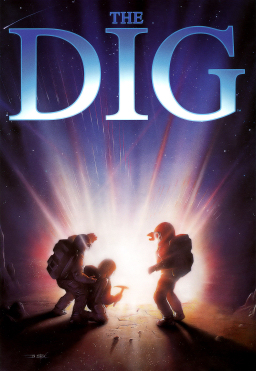
The Dig is a 1995 point-and-click adventure game developed by LucasArts for PC and Macintosh. Like other LucasArts adventure games, it uses the SCUMM video game engine. It features a full voice-acting cast, including voice actors Robert Patrick and Steve Blum, and a digital orchestral score. The game uses a combination of drawn two-dimensional artwork and limited, pre-rendered three-dimensional clips, with the latter created by Industrial Light & Magic.
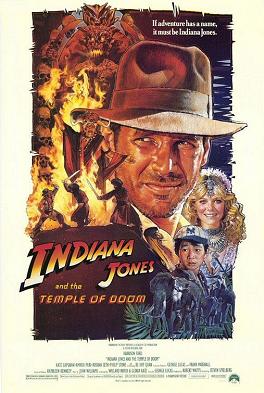
Indiana Jones and the Temple of Doom is a 1984 American action-adventure film directed by Steven Spielberg from a script by Willard Huyck and Gloria Katz, based on a story by George Lucas. It is the second installment in the Indiana Jones film series, but as a prequel to Raiders of the Lost Ark. The film features Harrison Ford who reprises his role as the title character. Kate Capshaw, Amrish Puri, Roshan Seth, Philip Stone and Ke Huy Quan, in his film debut, star in supporting roles. In the film, after arriving in British India, Indiana Jones is asked by desperate villagers to find a mystical stone and rescue their children from a Thuggee cult practicing child slavery, black magic, and ritual human sacrifice in honor of the goddess Kali.

Noah Falstein is a game designer and producer who has been in the video game industry since 1980, winning "Game of the Year" titles for multiple games such as Battlehawks 1942 and Indiana Jones and the Fate of Atlantis. He has designed games for multiple platforms, including arcade video games, Commodore 64, and MS-DOS.

From the late 1980s to the early 2000s, LucasArts was well known for their point-and-click graphic adventure games, nearly all of which received high scoring reviews at the time of their release. Their style tended towards the humorous, often irreverent or slapstick humor, with the exceptions of Loom and The Dig. Their game design philosophy was that the player should never die or reach a complete dead-end, although there were exceptions.

Indiana Jones and the Emperor's Tomb is a 2003 action-adventure video game developed by The Collective and published by LucasArts for the Xbox, Microsoft Windows, PlayStation 2 and OS X. It features cover art by Drew Struzan. The game is an adventure of fictional archeologist Indiana Jones. The story takes place in 1935, acting as a prequel to Indiana Jones and the Temple of Doom. The tomb mentioned in the title is that of China's first Emperor Qin Shi Huang.

Indiana Jones and the Kingdom of the Crystal Skull is a 2008 American action adventure film directed by Steven Spielberg from a screenplay by David Koepp, based on a story by George Lucas and Jeff Nathanson. It is the fourth installment in the Indiana Jones film series and a sequel to Indiana Jones and the Last Crusade (1989). Set in 1957, it pits Indiana Jones against Soviet KGB agents led by Irina Spalko searching for a telepathic crystal skull located in Peru. Jones is aided by his former lover, Marion Ravenwood, and their son, Mutt Williams. Ray Winstone, John Hurt, and Jim Broadbent are also part of the supporting cast.
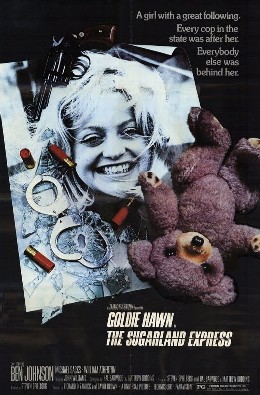
The Sugarland Express is a 1974 American crime drama film directed by Steven Spielberg in his theatrical debut, following the TV film Duel (1971). The film follows a woman and her husband as they take a police officer hostage and flee across Texas while they try to get to their child before he is placed in foster care. The event partially took place and the film was partially shot in Sugar Land, Texas. Other scenes were filmed in San Antonio, Live Oak, Floresville, Pleasanton, Converse and Del Rio, Texas.
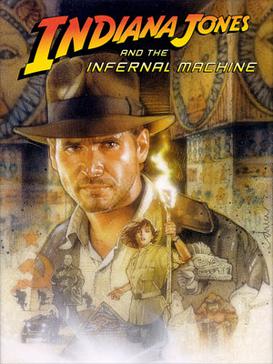
Indiana Jones and the Infernal Machine is an action-adventure video game by LucasArts released in 1999. The first 3D installment in the series, its gameplay focuses on solving puzzles, fighting enemies, and completing various platforming sections. The story is set in 1947, after the events of Indiana Jones and the Iron Phoenix, and puts the eponymous protagonist, the adventurer Indiana Jones, against the Soviet Union. In a race for a mythological Babylonian power source, he joins forces with the Central Intelligence Agency and collects four pieces of the Infernal Machine, an ancient device that allegedly opens a portal to another dimension.

Star Wars: Yoda Stories is a 1997 adventure video game based on the Star Wars franchise developed by LucasArts. The game is the second and last title in LucasArts' Desktop Adventures series, preceded by Indiana Jones and His Desktop Adventures. The game was released in March 1997 for Microsoft Windows and ported to Game Boy Color by Torus Games in December 1999.

Indiana Jones and the Staff of Kings is an action-adventure video game published by LucasArts for Nintendo DS, PlayStation 2, PlayStation Portable and Wii. It focuses on Indiana Jones as he searches for his former mentor Charles Kingston, while working to prevent the Nazis from acquiring the "Staff of Kings", said to be the same staff used by Moses to part the Red Sea. The Wii version includes a copy of a previous LucasArts game, Indiana Jones and the Fate of Atlantis, as an unlockable.

Indiana Jones' Greatest Adventures is a 1994 platform video game released for the Super Nintendo Entertainment System. It is a video game adaptation of the Indiana Jones films Raiders of the Lost Ark (1981), Indiana Jones and the Temple of Doom (1984), and Indiana Jones and the Last Crusade (1989). The game was developed by Factor 5 and published by JVC Musical Industries. The story is told through cutscenes and text and is mostly faithful to the movies. Its release coincided with that of Super Star Wars: Return of the Jedi, also released by JVC and LucasArts and in the same platform style as the Super Star Wars trilogy.
Indiana Jones is an American media franchise consisting of five films and a prequel television series, along with games, comics, and tie-in novels, that depicts the adventures of Dr. Henry Walton "Indiana" Jones, Jr., a fictional professor of archaeology.

Matthew Robbins is an American screenwriter and film director best known for his writing work within the American New Wave movement.
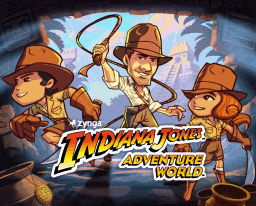
Indiana Jones Adventure World is a defunct adventure game for the social network Facebook, released in 2011. It is the first game made by Zynga's Boston development studio, made up of developers from Conduit Labs and Floodgate Entertainment. Adventure World was originally made independent of Indiana Jones, but after Zynga reached a deal with Lucasfilm to bring Indiana Jones to Adventure World, Indiana Jones appeared in off-screen cameo roles. On November 29, Indiana Jones was added to the game in a chapter dedicated to the character called "Calendar of the Sun". At this time, the title was changed to Indiana Jones Adventure World. Hal Barwood, the co-writer and co-designer of Indiana Jones and the Fate of Atlantis and writer and designer of Indiana Jones and the Infernal Machine worked on Indiana Jones Adventure World in the area of narrative design. Game writer Jonathon Myers has provided narrative support in the wake of Hal Barwood's contribution.
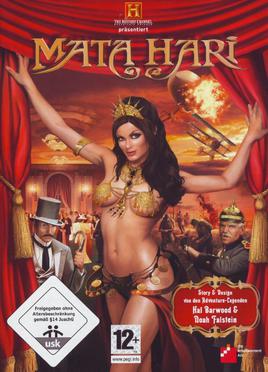
Mata Hari is an adventure video game. It was released on November 21, 2008, in German-speaking territories. The game was worked on by ex-LucasArts alumni Hal Barwood and Noah Falstein.



















